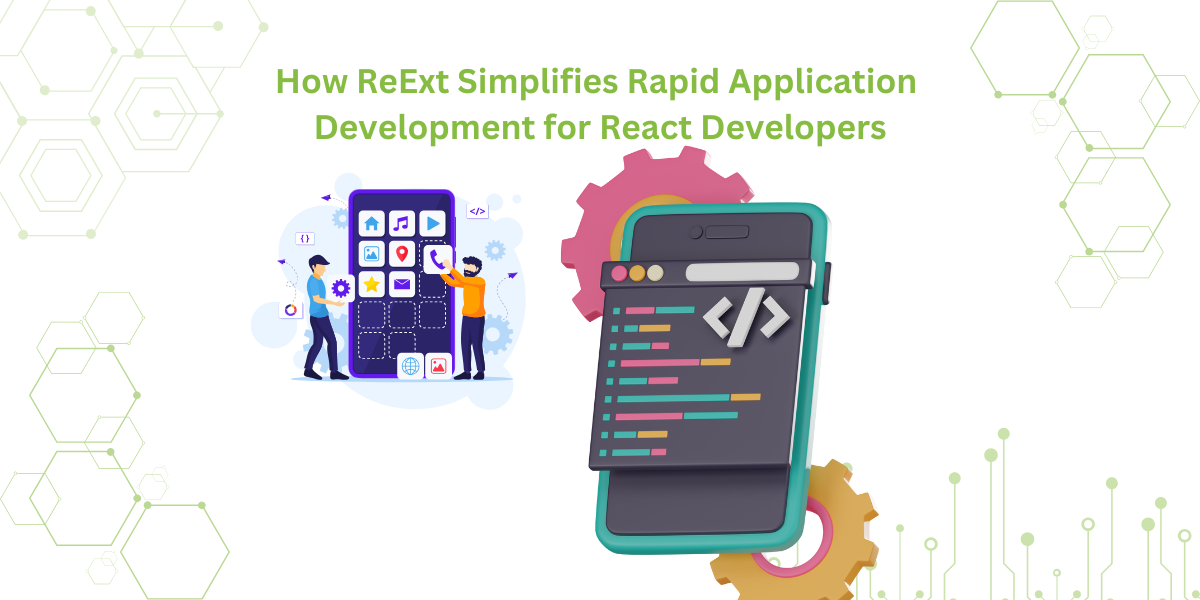How ReExt Simplifies Rapid Application Development for React Developers
Get a summary of this article:

It also results in faster development with 140+ ready-to-use components. It’s ideal for teams needing fast, consistent results in modern app projects.
React is a popular option for creating modern websites. It’s simple to get started and adaptable enough to practically any project, from a dashboard to a complex enterprise-grade application.
However, as the app grows, challenges arise. Code duplication becomes common. The UI starts falling short of requirements, and performance begins to dip.
That’s where ReExt steps in. It combines Sencha Ext JS’s powerful user interface with React JS’s flexibility. It allows it to be one of the best tools for rapid application development. Among the key features of RAD tools are visual development interfaces, reusable components, real-time previews, and rapid prototyping — all of which ReExt delivers to accelerate React-based enterprise app creation.
Using Sencha Rapid Application Development, developers can quickly build high-quality cross-platform apps with less code and faster time-to-market.
With over 140 pre-built Ui components and easy integration, ReExt supports faster, scalable development. It’s a perfect fit for teams using rapid web application development methods and RAD (Rapid Application Development) tools.
Whether you’re creating a prototype or a full-scale enterprise solution, ReExt enables rapid project management. It offers you seamless development with less effort and more consistency.
As projects grow, keeping things smooth gets tricky.
But ReExt makes this task easy for developers. You get clean layouts and responsive screens without having to fight with code.
What is Rapid Application Development?
Rapid Application Development (RAD) is a software development technique that prioritizes quick prototyping and review during long project cycles. It focuses on adaptability, iterative design, and the use of rapid software development tools and technologies.
With solutions like ReExt, developers can focus on developing critical functions. They do not need to start from scratch. This paradigm excels when deadlines are tight and user feedback is critical.
Advantages of Rapid Application Development include:
- Faster prototyping and iteration.
- Reduced development time.
- Early user comments.
- More flexibility in changing requirements
- Ideal for web-based quick application development.
ReExt is an excellent example of a quick application development tool. It embodies all these benefits.
Understanding ReExt
ReExt is a hybrid development framework. It combines React’s component-based structure with the Ext JS design system. It brings web rapid application development with Outsystems-like simplicity to React developers by offering a set of ready-made, customizable components.
Whether you’re using a React JS function component, a React JS table component, or building dashboards, ReExt helps you move fast. It doesn’t sacrifice flexibility. It enables developers to work in the rapid application design model. This makes it easier to create web applications that scale.
Why ReExt Works:
- Offers 140+ reusable, UI-rich components
- Supports data binding, forms, grids, layouts, and charts
- Integrates directly into any React JS app
- Maintains consistent UI across the app
- Works for simple UIs or full-scale enterprise systems
ReExt cuts down on manual UI handling. It fits well within any rapid web app development workflow.
Also Read: Build Faster and Smarter with Rapid App Development Using Ext JS
Common Challenges in React Development
React frameworks are great for developing applications, but scalability causes challenges. Developers have to deal with repetitive code, complex state management, and varying user interfaces. With the help of a built-in UI system, ReExt speeds up the process.
React is efficient, but it also causes trouble. With the scalability of apps, the following challenges may emerge:
1. Building Components from Scratch
React lacks built-in UI components like tables, grids, and charts. Developers spend hours creating boilerplate code or frameworks. Adding sorting and paging to a React JS table component becomes challenging.
2. Managing State and Performance
State management becomes complex with larger apps. Redux, the Context API, and memoization are all useful tools. However, scaling increases overhead.
3. UI Consistency and Customization
Each part of the UI needs custom styling. Without a unified React components library, the app can become messy. It becomes inconsistent and harder to maintain.
ReExt solves all these challenges. It uses an integrated UI approach that fits well within a rapid application development model.
How ReExt Solves Developer Problems
Pre-built and customized user interface components
Grids, charts, buttons, forms, and panels are examples of ReExt components with the capability to drag and drop. Developers can build an entirely operational React JS grid component without starting from scratch. It allows for complete customisation while retaining a consistent appearance.
This speeds up MVPs and shortens delivery times. That’s exactly what rapid application development tools are meant to do.
Simplified Data Management
ReExt includes built-in data stores, models, and two-way binding. You don’t need Redux or external tools for syncing API data. These capabilities are precisely aligned with best practices for rapid web application development frameworks.
ReExt’s cross-platform responsive design ensures apps adjust to various screen sizes. There is no need for further code. The layout changes to provide a consistent user experience on desktop, tablet, and phone devices.
Shorter Development Cycles
ReExt allows quick changes and easy testing. Whether you need to replace a React JS switch component or adjust a layout, the approach is straightforward. This is ideal for RAD software development tools when speed is critical.
Key Benefits of ReExt for React Developers
Consistent UI Across the Board
In ReExt, all the components share a design system based on Ext JS. This ensures that no matter how many people are working on the project, the final product looks polished and uniform.
There is no need to be worried about design conflicts. The system keeps everything looking the same. That’s a huge time saver.
New team members can jump in without confusion. They follow the same structure from day one. That keeps collaboration smooth and code clean.
Prototyping and MVP development
Need to test ideas quickly? ReExt is the right tool. It allows teams to put together working prototypes without spending time on low-level coding. It’s ideal for rapid web app development.
While testing new features, rapid iterations are necessary. ReExt helps you to test and get feedback quickly. That’s essential for modern product cycles.
You can go from idea to demo in days. No need to build each part from scratch. ReExt has you covered with ready pieces.
Easy customization
ReExt allows you to fully customize any component. This makes it ideal for specialized enterprise mobile app development. It’s perfect for apps that require tight branding rules.
No two companies want the same look. ReExt lets you match your exact design without heavy lifting. It adapts to your needs.
Need a unique layout? Or a brand-specific style? You can tweak components easily without breaking the flow.
Scalability
Whether building modest projects or commercial apps, ReExt is one of the best choices. It handles complex interfaces and logic with ease. Use it to create dashboards, CRM systems, and real-time analytics platforms.
As the project expands, the basic framework remains solid. You won’t hit a wall with too much data or logic. ReExt is built to handle scale.
It performs well under pressure. Heavy data processing and large traffic do not slow it down. It is crucial for large enterprise level applications.
Use Cases for ReExt in Rapid Application Development
Enterprise Software
ReExt’s structured, scalable nature benefits applications such as CRM, ERP, and HR systems. It’s built for apps with thousands of records, roles, and views.
Dashboards and Reporting Tools
Thanks to built-in charting and data handling, ReExt is ideal for dashboards. It’s React JS grid component easily handles filtering, pagination, and more.
Cross-Platform Applications
ReExt’s responsive design makes it easy to build once and deploy everywhere. That’s a key aspect of rapid application tools for modern businesses.
MVP and Prototyping Projects
ReExt significantly reduces development time for startups or agile teams. Launch MVPs fast without sacrificing UI quality.
Data-driven web apps
ReExt’s smart grid and form components are useful for applications that handle massive amounts of data. Consider financial dashboards, management of inventory, or supply chain tracking.
How ReExt Fits the Rapid Application Development Model
The rapid application development software model encourages modular design, reusable components, and continuous iterations. Data-centric web applications.
ReExt’s smart grid and form components are beneficial for applications that deal with large datasets. Consider accounting dashboards, inventory management, and supply chain tracking. reExt naturally supports it:
- By offering reusable components for rapid assembly
- Providing quick layout changes with minimal impact
- Offering faster feedback loops from users.
Everything that a RAD development is supposed to promote is represented here: collaboration, speed, and adaptability.
Developers often lose time fixing small UI issues or setting up basic elements. ReExt handles such elements from the start. It means less concern for minor details and more emphasis on the major aspects.
Conclusion
ReExt isn’t just a framework. It’s a quick Application development software that prioritizes speed and efficiency. ReExt’s built-in, ready-to-use components and responsive design capabilities significantly minimize development time.
It simplifies data administration and helps manage complex, scalable projects. Whether you’re building dashboards, commercial applications, or brief MVPs, ReExt is considered to be the top choice. It allows developers to work quickly while maintaining quality.
It is one of the best software development tools, particularly for React ecosystems. Begin developing smarter with ReExt and enjoy the full benefits of rapid application development. You don’t need to start from scratch. With ReExt, much of the heavy lifting is already done. That’s what makes it different from many other tools out there.
The components are customizable, but still maintain consistency. It makes apps look clean and be adaptive across different devices. That means you don’t have to spend time fixing screen issues.
Instead of keeping extensive external UI libraries, it maintains a streamlined system. Everything works together out of the box. That keeps your project clean and easy to maintain.
If you’re working on a product that needs to scale, ReExt handles it well. From internal interfaces to enterprise wide platforms, it scales with user requirements. It won’t hold you back.
Developers can also focus more on logic instead of layout. That’s where real progress happens. It’s what makes ReExt such a productive tool.
FAQs
What is the definition of rapid application development in software engineering?
It’s a development strategy that emphasizes speed and iterative modifications by leveraging reusable components and providing quick feedback.
What is the quick application development methodology?
It uses prototype, iterative design, and user input to accelerate software delivery.
What happened to RAD development?
RAD has evolved. It’s no longer just a methodology. It’s embedded in tools like ReExt and OutSystems.
How to make a web-based application?
Use a front-end library like React with tools like ReExt. Connect it to backend services via APIs.
How can I integrate this code with a web application?
ReExt provides easy integration with React-based web apps. Just import the components and bind them to your data source.
How long does it take to develop a web application?
With RAD tools like ReExt, small apps can be built in days. Complex apps may take a few weeks to months.
What web technologies are used to develop web applications?
HTML, CSS, JavaScript (React and Angular), REST APIs, and user interface technologies such as ReExt.
How do RAD tools impact team collaboration?
They make it easier for developers and stakeholders to stay in sync by supporting quick changes and visual feedback.
How does ReExt help during prototyping?
It gives you ready-made components so you can build working screens without spending time on UI from scratch.
Is RAD only for web apps?
Nope. It also works for mobile and cross-platform apps when paired with the right tools.
Build powerful React apps faster—start your free Ext JS trial today!

For Independent Software Vendors operating in competitive global markets, the user interface has evolved from…

The selection of a front end framework for enterprise applications remains one of the most…

Every software project begins with a choice that reverberates through its entire lifecycle: which development…









